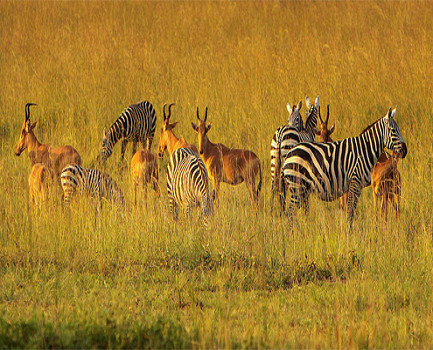
Kidepo Valley national park lies in the far northeastern part of Uganda and very isolated from the rest of the country by the sparsely populated, arid badlands of the Karamoja still offering the best and untouched wildlife encounters in Africa only that it is on a few Uganda tour operators’ websites till recent when many of these are starting to feature it, the not visits to the park are majorly due to its accessibility which might take not less than 14 hours if getting there by road from Kampala.
Kidepo Valley National Park covers an area of 1,442 sq. kilometers, lying between 910 – 2750 meters above sea level. The highest point in the park is mount Morungole which lies just on the Sudanese border and view-able from different points in the park. The mountainous terrain is broken by the Narus valley in the southwest and the Kidepo valley in the northeast which make the park diverse and hold unique wildlife. The dominant habitat is open or lightly wooded savanna, on a single visit to the park, one will note that it is interspersed with patches of montane forest, riparian woodland, all decorated with beautiful looking borassus palms and rocky koppies. The national park once had 86 mammal species now reduced to 77 after a rash of local extinction in recent years. The bird checklist of 463 confirmed and 26 unconfirmed species is second only to Queen Elizabeth National Park, and more than 60 of the birds listed have been recorded in no other Ugandan national park making it a must visit destination to bird watchers visiting Uganda.
Five primate species have been recorded in Kidepo, including the localized patas monkey. Predators are particularly well represented, with 20 resident species. Of these, the aardwolf, black-backed jackal, bat-eared fox, cheetah and caracal are found in no other national park in Uganda except here. Other predators recorded in Kidepo are the side-stripped jackal, spotted hyena, lion, leopard, and a variety of mustelids, genets, mangoose and small cats. Twelve antelope species occur in Kidepo of which the greater kudu, lesser kudu, Guenther’s dik-dik, and mountain reedbuck occur nowhere else in Uganda making this indeed a unique destination. Other antelope species found in Kidepo are Jackson’s hartebeest, eland, bushbuck, klipspringer, common duiker, Oribi, Defassa waterbuck, and bohor reedbuck. Kidepo also supports populations of elephant, Burchell’s zebra, warthog, bush pig and buffalo. The black rhinoceros recently became extinct in Kidepo, but giraffes have been saved from local extinction by the translocation of several animals from Kenya. Kidepo’s long bird checklist is made even more impressive by the relatively small size of the park and the fact that as many as 100 of the birds listed are either dry-country species which within Uganda are practically confined to Kidepo, or else northern or eastern species which have been noted elsewhere only in the north of Murchison falls National Park and in the mount Elgon area. Raptors are particularly well represented: 56 species in total, of which the most commonly observed, are the dark chanting goshawk, pygmy falcon, tawny eagle, bataleur, secretary bird and several types of vultures. Other birds which must be regarded as kidepo’s specials, at least within Uganda, include the ostrich, white-bellied go-away bird, Kori bustard, fox and white eyed kestrels, , carmine, little green and red-throated bee-eaters, Abyssinian roller, Abyssinian scimitarbill, d’Arnauds, red and yellow and black-breasted barbets, red-billed, yellow-billed and Jackson’s hornbill, Karamojong apalis, Rufous chatterer, chestnut weaver, red-billed and white-headed buffalo weavers, northern brownbul, golden pipit, and purple grenadier – to name only a few but the checklist is ongoing.
Isolated form Uganda’s mainstream by the harsh plains of the Elgon Kidepo is one the Africa’s last great wilderness areas, a tract of rugged savannah dominated by the 270m mount Morungole and transected by the Kidepo and Naurus rivers. Perennial water make Kidepo an oasis in the semi desert, reflected in its 86mammal species (28 being endemic to this valley) and almost 500 bird species. Predators are well represented-lion, cheetah and leopard, but also the delightful bat-eared fox and insectivorous hyena-like aardwolf- while a long list of dry country antelopes include the regal greater Kudu and beissa Oryx. While game viewing can be excellent it is the thrilling sense supreme isolation that distinguishes this rare slice of wild Africa, as yet been undiscovered by the mass safari market.
A number of activities have been registered in the wilderness park virgin waiting to be discovered.
Game drives: these can be down along the Naurus valley as the wildlife congregates here much of the year. This area has adequate tracks circuits enabling visitors vie w animals at a close range at the katurum kopie provides superb views north across the valley towards Morungole mountain ranges.
Nature walks: Nature walks can be done around the Apoka camp at any time of the day, visitors will be able to view species of animals like the zebras, elephants, bulbul, and reedbucks. At the eastern Kakine circuit, visitors can see wildlife at a close range of upto50-70metres. Nature walks can alsobe done along Rionomoe trail and around this hill where one can view the lower side of the Naurus valley.
Community Walk: community walks are one of the ways one can get to know more about the Karamajong lifestyle, cultures, dressing style, dancing, and the tools used. The Karamajong are traditionally cattle raiders and hunters. However through community conservation education their lifestyle is gradually changing and most of them now know the value of conserving the park.
Mountain Hiking: The Morungole ranges rise from the plains a few kilometers north of Apoka. A trip to Kidepo valley is needed to get a good view of Morungole Mountain, the highest peak in Kidepo. Even at 2749m, this peak is not easily seen from most vantage points in the Naurus valley. This can be explored on foot with a ranger guide escort.
Sand along the River Kidepo: Kidepo River is an intermittent sand river found in the northern part of the park. It stands out because it is lined by borassus palms, making it look like an oasis in the Sahara. The sand bed experience on the river bed Kidepo can be very fascinating especially during the dry season. Many bird species can be seen around this area and one can enjoy the wilderness experience while listening to the difference beautiful songs of the different birds.
Bird Watching: this activity can be done either in the morning or afternoon and the park has got a variety of birds. The experienced guides will show you around.
There are four routes by road: the 705km from Kampala via Lira, Kabong and then Kidepo. The 740kms journey from Kampala via Mbale, soroti, Moroto, Kotido, Kabong and then Kidepo, the 78km journey form Kampala to Mbale, soroti, matany, Moroto, Kotido, Kabong and then Kidepo, and the 571km journey from Kampala through Gulu, Kitgum and to Kidepo. Driving through the wilderness can be exciting as visitors can pounce on a chance of better scenery. A 4x4wheel drive is necessary especially in the rainy season
Chatter air flights to Kidepo can be arranged from Kajansi or Entebbe international airport to Lomej airstrip near the park headquarters. Flight takes two hours. However there is scheduled flight to Kidepo from the international airport once a day.
4 Days Safari To Kidepo Valley National Park Uganda
Day One

Your guide will pick you from your hotel and transfer you to the airport for a brief flight to a very remote area in Uganda. Enjoy lunch in Apoka lodge and best of all is the fact that you can actually see some animals in the lodge vicinity even before your afternoon game drive. You may as well enjoy a swim in the swimming pool.
Have a Game Drive in the afternoon in the Narus Valley and there you will see numerous buffaloes, zebras, elephants plus giraffes, and if lucky lions, cheetahs plus leopards. In addition there are numerous bird species along the way. This drive is really slow offering you wonderful opportunities take pictures of animals, birds, trees, butterflies and plants. You will dine and slumber at your lodge.
Day Two
Today you will have a wonderful breakfast after which you will have another fascinating game drive through the arid river bed, savannah, small forests, hills plus the foothills of the mountains to marvel at the impressive flora and fauna in the area.
You will continue to the Karankorog Hot Springs as you see numerous animals along the way. Each game drive is drive is different even when you repeat the very route more than once. The scenery, birds and animals will certainly be very impressive so remember to bring along your camera.
Have Lunch back at Apoka Lodge and in the afternoon spend some time with the Karamajong people on cultural tour learning about their culture and norms. Their passion for cattle is best matched with that of the Maasai of Tanzania as well as Kenya. They are very proud of their culture and they are proud warriors who believe that God gave them a right to all cattle as well as that belonging to other people. You will observe their fascinating lifestyle, their ways of cooking, dancing, and cattle keeping. Head back to Apoka Lodge to rest dine and sleep as you enjoy the thrilling sounds of nature in Kidepo Park.
Day Three
Another hefty breakfast as you enjoy the impressive melodies of birds in the surrounding trees. You will have a game drive in the morning within the remote parts of the park to view birds and different wild animals.return to Apoka Lodge for Lunch in the afternoon relax by the pool or have a guided exciting nature walk searching for various animals. Dinner and have the overnight at Apoka Lodge.
Day Four
Today, have your final breakfast at the Lodge before going for a guided nature walk to see birds, return for lunch back at the lodge and then head back to the capital and this will be the end of your safari.
